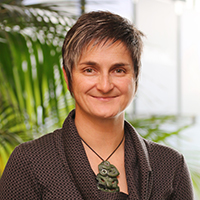Keynote - Tō reo ki te raki, tō mana ki te whenua
Hana O’Regan

ABSTRACT:
How many of our people have had control over their own personal and cultural narratives as Māori and as Māori learners as
they have travelled along their educational pathways? How many of us have successfully been able to influence the views of
those around us with regards to the value of our language and culture and our ability to achieve educational success as Māori?
As educators and educational leaders, what tools have we had at our disposal to grow the capability of our sector to support
the development of positive dispositions of the Māori learner?
THE DANGER OF A STORY UNTOLD:
Our children are often confronted with the effect of our history, but not enlightened as to the cause. The danger of this is that
they are left to think, often unconsciously - that the educational stereotypes many of our whānau face today - are because they
are Māori.
Generally the negative stories are what we hear about with Maori learners - the potential, stereotypes, challenges - this is what
students now think about themselves as learners.
This will continue to be the model unless the attitudes of people around them change - what do we think, share, believe and
what is our perception of Maori learners.
Capability Development Requires Cultural Self-belief
To create an environment that supports the growth and development of our children’s capabilities, we must start with ourselves
as educators and the message and stories we share and know.
Acknowledge the existence of negative messages
Acknowledge how societal messages shape people's perceptions and students perceptions of themselves
Understand where these perceptions have come from
Identify what needs to change and how we do this
1. What are the commonly known characteristics or emblems of the New zealand / Kiwi identity?
When people think about and talk about ‘kiwis’ what do they think/say?
2. What are the commonly known characteristics or emblems about Maori?
How can we protect our Maori students from the messages they are receiving from society?
If we hope to disestablish the negative cultural self believe then we as educators need to change the narrative and be prepared
to challenge the views to negate the negative stereotypes.
Maori being the tail, kinesthetic learners who are good with their hands and not really the academic types. These are the stories
our children hear about themselves rather than the success stories - 47 different Te Reo Maori newspaper publications to show that
at the turn of the century more Maori speakers where literate (80%) than non-Maori (20%). Success stories of famous Maori people,
Maori academic success, in the past which are forgotten and not told and taught in schools today. By making the links between
these success stories our students will be able to align themselves and make connections between their own learning and option.
Imagine if these heroic and significant success stories were told to our Maori children as much as we celebrate Sir Edmund Hillary
and Neil Armstrong.
















